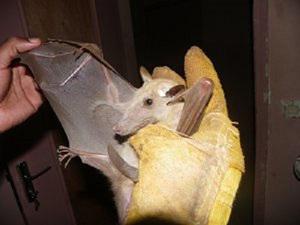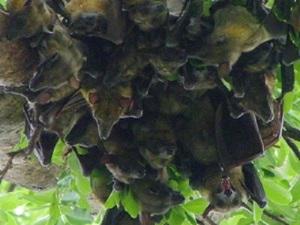Eric Moise Bakwo Fils
Other projects
24 Jul 2008
Contribution to the Knowledge of Fruit Bats of the Southern Cameroon Rainforest: Implication for Seed Dispersal and Forest Conservation
The overall aims of this project is to investigate the role of the fruit bat Eidolon helvum to seed dispersal and survival in Azadirachta indica, a valuable and multipurpose tree in the Sahelian region of Northern Cameroon.

Epomophorus gambianus.
Despite the ecological and economical importance of bats in tropical region, few policy makers understand the extent to which tropical ecosystems depend on bats for their survival. Thus, bats rarely receive the research or conservation attention that carry back more visible and popular wildlife species in Africa. These controversial and misunderstood animals rank among the most persecuted and threatened animals worldwide and they are not even considered in long term plan for sustainable use of tropical ecosystems.

Cameroonian’s frugivore community is relatively depauperate in the Sahelian region and large mammals are mainly restricted within the few remaining areas of savannah. Then large sized and long-range flying fruit bats seems to be the main disperser of seeds for the plants that provide their diet.
Azadirachta indica (Neem) is one of the most valuable multipurpose trees of the arid and semi-arid zones, particularly valued for the basic needs of rural households, like medicines (anti-allergic, anti-fungal, anti-inflammatory, cardiac, diuretic, etc.), pesticides, nematicides, insect repellent, fertilizers, fodder, soaps, lubricants, tooth brushes, reforestation etc. Previous observations made in the Sahelian region of Cameroon suggested that this plant may rely on the straw-coloured fruit bat (Eidolon helvum) for effective seed dispersal. Providing evidence of this relationship would provide a strong economic and ecologic argument to change the current status of large colonies of Eidolon from persecuted to protected.
Methodology
Capture: Study site will be sampled monthly for bats species and theirs numbers. Each sampling event will consist in 6 consecutive capture nights (18h-24h) using four mist nets per site. Each captured bats will be identified, pictured, measured, weighted and sexed.
Faecal collection: Eidolon’s diet will be studied by analysing faecal samples collected in bags during captures, and faeces collected on plastics sheets placed beneath day roosts (colony of Maroua). Seeds found in faecal samples will be identified and counted.
Focal tree observations: 500 hours of diurnal and nocturnal observations will be conducted in staggered 2-3 hours block at 10 focal Azadirachta trees. We will record the species or taxa and number of all animals observed when visiting or feeding on fruits, in or below the focal tree crowns. We will determine the feeding rate and record information on fruit handling.